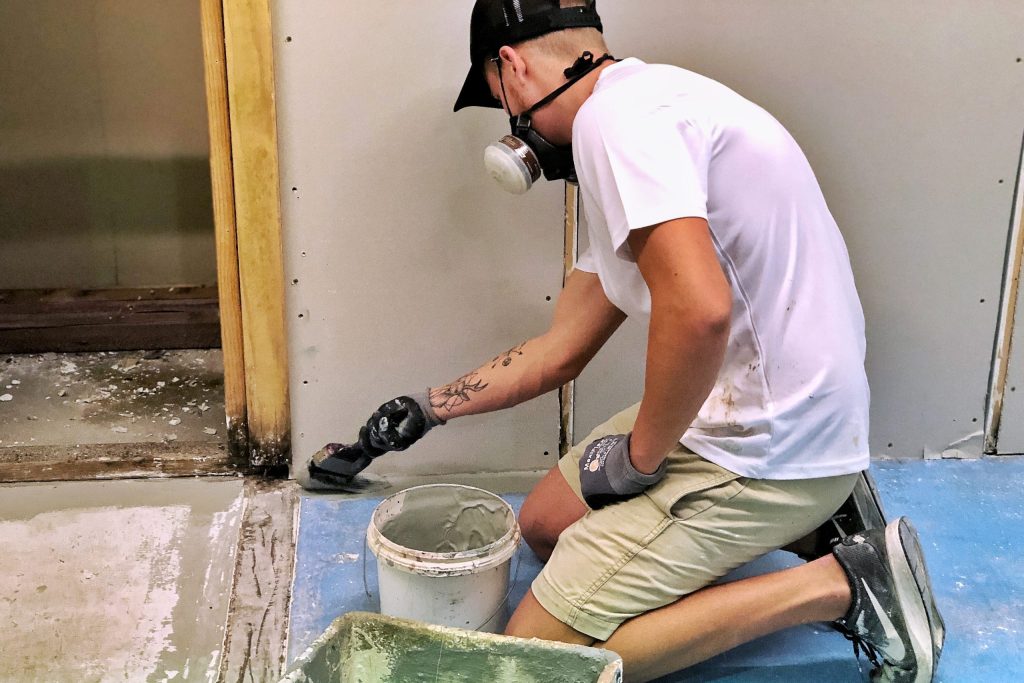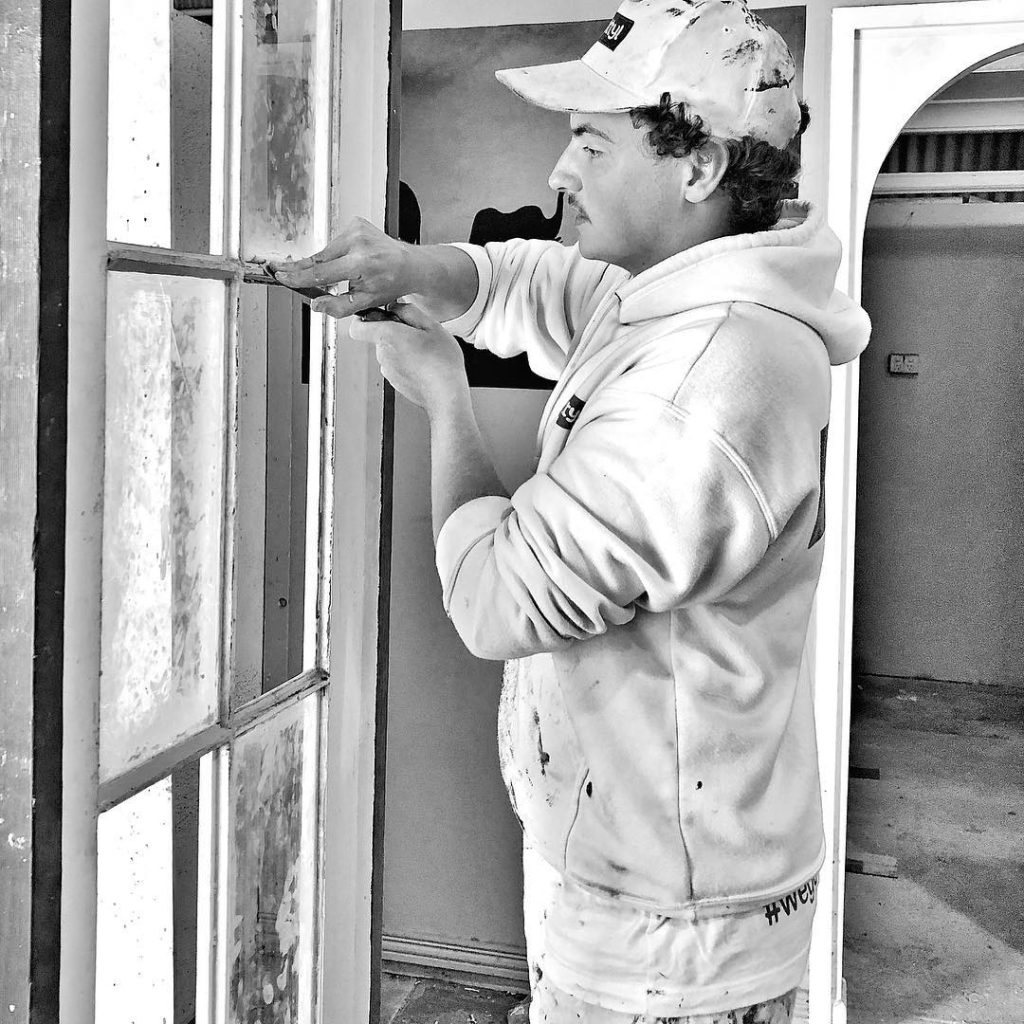The Key to Success
Thorough preparation is the cornerstone of any painting project. It can either facilitate a smooth and seamless process or, if overlooked, can lead to a world of problems. The first step in the preparation process depends on the type of surface you are working with. Common surfaces encountered in painting projects include drywall, plasterboard, timber cladding or siding, stucco, fibro cement sheeting, doors, window architraves, and metal rails and posts. Regardless of whether the project involves new surfaces or is a repaint, it is of utmost importance to ensure that the surface is clean, structurally sound, and free from dust and contaminants. For repaint projects, conducting an Adhesion Test is highly recommended to ascertain the soundness of existing paint layers. Additionally, when dealing with older structures, it is imperative to be mindful of the potential presence of hazardous materials such as Lead-Based Paint and Asbestos.

These materials pose significant health risks and should be handled with extreme caution. Therefore, comprehensive preparation is not only essential for achieving a visually appealing result but is also crucial for ensuring the safety and durability of the paintwork. In summary, the preparation process involves several key steps, including cleaning the surface, repairing any damages, sanding, and priming. Each of these steps is critical and must be executed with care and attention to detail. Proper preparation will not only ensure a professional finish but will also contribute to the longevity of the paintwork. Therefore, it is essential to invest the necessary time and effort into the preparation process to guarantee a successful painting project.

These materials pose significant health risks and should be handled with extreme caution. Therefore, comprehensive preparation is not only essential for achieving a visually appealing result but is also crucial for ensuring the safety and durability of the paintwork. In summary, the preparation process involves several key steps, including cleaning the surface, repairing any damages, sanding, and priming. Each of these steps is critical and must be executed with care and attention to detail. Proper preparation will not only ensure a professional finish but will also contribute to the longevity of the paintwork. Therefore, it is essential to invest the necessary time and effort into the preparation process to guarantee a successful painting project.

Selecting the appropriate paint is crucial for achieving a professional and durable finish. Different surfaces and environments require different types of paint. For example, walls and ceilings are best painted with flat or matte paint, while semi-gloss and gloss paints are ideal for kitchens, bathrooms, and trim. Exterior surfaces require paint that can withstand the elements, and wood and metal surfaces require special primers and paints. Additionally, consider the mood you want to create in the room as the colour you choose will set the tone. Testing a small area before painting the entire room is always a good idea.
Before 1970, most paints used on Australian homes contained high lead levels. So if you own a home built before 1970, it’s essential to understand the risks associated with lead poisoning.
Selecting the appropriate paint is crucial for achieving a professional and durable finish. Different surfaces and environments require different types of paint. For example, walls and ceilings are best painted with flat or matte paint, while semi-gloss and gloss paints are ideal for kitchens, bathrooms, and trim. Exterior surfaces require paint that can withstand the elements, and wood and metal surfaces require special primers and paints. Additionally, consider the mood you want to create in the room as the colour you choose will set the tone. Testing a small area before painting the entire room is always a good idea.
Before 1970, most paints used on Australian homes contained high lead levels. So if you own a home built before 1970, it’s essential to understand the risks associated with lead poisoning.

Here are some professional tips to achieve a durable finish with ease:
Use Quality Paint: Invest in high-quality paint for better coverage, durability, and ultimately, cost savings in the long run.
Use the Right Tools: Use appropriate brushes and rollers for the type of paint and surface you are working on.
Paint in the Right Order: Start by painting the ceiling, then the walls, followed by the trim, doors, and finally the floor.
Use Proper Technique: Apply paint in a ‘W’ pattern and then fill in the gaps with horizontal strokes for even coverage and reduced roller marks.
Allow Proper Drying Time: Allow the paint to dry completely between coats to avoid peeling or cracking.
Here are some professional tips to achieve a durable finish with ease:
Use Quality Paint: Invest in high-quality paint for better coverage, durability, and ultimately, cost savings in the long run.
Use the Right Tools: Use appropriate brushes and rollers for the type of paint and surface you are working on.
Paint in the Right Order: Start by painting the ceiling, then the walls, followed by the trim, doors, and finally the floor.
Use Proper Technique: Apply paint in a ‘W’ pattern and then fill in the gaps with horizontal strokes for even coverage and reduced roller marks.
Allow Proper Drying Time: Allow the paint to dry completely between coats to avoid peeling or cracking.

Proper preparation of interior and exterior surfaces is essential for a professional and lasting finish. It involves cleaning the surface, repairing damages, sanding, and priming. Cleaning removes dirt, grease, or loose paint, ensuring proper paint adhesion. Repairing damages involves filling holes, cracks, or dents with a suitable filler and allowing it to dry completely. Sanding creates a smooth and even base for the paint to adhere to and removes any remaining loose paint or rough edges. Applying a coat of primer creates a uniform surface for the paint to adhere to and covers any stains or dark colors. Proper interior and exterior preparation is crucial for achieving a professional and lasting finish.
Before 1970, most paints used on Australian homes contained high lead levels. So if you own a home built before 1970, it’s essential to understand the risks associated with lead poisoning.
In conclusion, proper painting preparation is the key to a successful painting project. It involves selecting the right paint, using the right tools and techniques, and properly preparing the interior and exterior surfaces. Additionally, it is crucial to be aware of potential hazards like Lead-Based Paint and Asbestos in older buildings. Investing time and effort in proper painting preparation will not only ensure a professional finish but also a project that lasts for years. Therefore, it is crucial not to overlook the importance of painting preparation. Remember, taking the time to do the job right will result in a professional-looking finish that will last for years.
Proper preparation of interior and exterior surfaces is essential for a professional and lasting finish. It involves cleaning the surface, repairing damages, sanding, and priming. Cleaning removes dirt, grease, or loose paint, ensuring proper paint adhesion. Repairing damages involves filling holes, cracks, or dents with a suitable filler and allowing it to dry completely. Sanding creates a smooth and even base for the paint to adhere to and removes any remaining loose paint or rough edges. Applying a coat of primer creates a uniform surface for the paint to adhere to and covers any stains or dark colors. Proper interior and exterior preparation is crucial for achieving a professional and lasting finish.
Before 1970, most paints used on Australian homes contained high lead levels. So if you own a home built before 1970, it’s essential to understand the risks associated with lead poisoning.

In conclusion, proper painting preparation is the key to a successful painting project. It involves selecting the right paint, using the right tools and techniques, and properly preparing the interior and exterior surfaces. Additionally, it is crucial to be aware of potential hazards like Lead-Based Paint and Asbestos in older buildings. Investing time and effort in proper painting preparation will not only ensure a professional finish but also a project that lasts for years. Therefore, it is crucial not to overlook the importance of painting preparation. Remember, taking the time to do the job right will result in a professional-looking finish that will last for years.
Before 1970, most paints used on Australian homes contained high lead levels. So if you own a home built before 1970, it’s essential to understand the risks associated with lead poisoning.
I trained under Nigel as an apprentice, now I am happy to say my apprentice is training under him also. I really enjoyed my time on the training wheels, and to be honest, Nigel seems to be one of the few driven by passion for our trade. 5 stars, anyday.
This is the number one place to go if you have any questions to do with the painting trade. It is so heart-warming to see an organisation like this that is dedicated to help out and improve our industry. They are up-to-date with Government Legislation and forward the information on, even if you’re not a member. They are also passionate about assisting painters to better their own business to become more profitable. Aussie Painters Network deserves a 5 star rating in my book. Keep up the good work.
Very happy with the service! Great knowledge that has helped me grow and realise a few things I need to improve on.
Top site and wealth of knowledge and commitment to the guys on the tools.
I have dealt with Aussie Painters Network a few times over the years & found them to be very helpful, Polite & friendly, their magazine is always informative & even if you only get one thing from it, that’s a positive thing. Keep up the good work.
I want to take this opportunity to thank and congratulate the APN team for all the work they do to help educate, train and support our painting industry.
Well done mate…!
Aussie Painters Network
2/16 Perrin Place
Salisbury Qld 4107
We’re open 7:00 am — 3.00 pm Monday – Friday. Saturday and Sunday Closed.
For additional questions you can call us at 1800 355 344 or you can find us on 0430 399 800
Aussie Painters Network
2/16 Perrin Place
Salisbury Qld 4107
We’re open 7:00 am — 3.00 pm Monday – Friday. Saturday and Sunday Closed.
For additional questions you can call us at 1800 355 344 or you can find us on 0430 399 800
Monday – Friday : 7:00 am — 3.00 pm
Saturday and Sunday : Closed